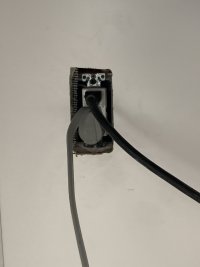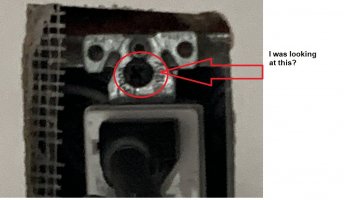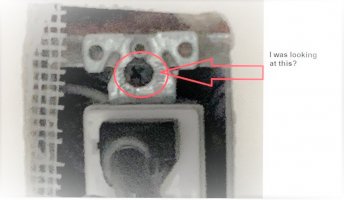-
Welcome to The Building Code Forum
Your premier resource for building code knowledge.
This forum remains free to the public thanks to the generous support of our Sawhorse Members and Corporate Sponsors. Their contributions help keep this community thriving and accessible.
Want enhanced access to expert discussions and exclusive features? Learn more about the benefits here.
Ready to upgrade? Log in and upgrade now.
You are using an out of date browser. It may not display this or other websites correctly.
You should upgrade or use an alternative browser.
You should upgrade or use an alternative browser.
Even a Goof-Ring Can't Fix This
- Thread starter jar546
- Start date
fatboy
Administrator
Looks like the grounding plug is down. I know thats an items of discussion, based on the AHJ. In this case would you flip the receptacle so the grey cord doesnt have the sharp bend?
I wouldn't require it, that is a workmanship issue.
Some will argue it is in fact safer, the the energized blades of the plug are not going to be placed in a position that it could be potential hazardous. (not me)
Builder Bob
SAWHORSE
Makes it harder to do the stupid coin on the prongs plug in challenge -----
The attachment plug is beyond the scope of my authority.Looks like the grounding plug is down. I know thats an items of discussion, based on the AHJ. In this case would you flip the receptacle so the grey cord doesnt have the sharp bend?
Looks like the grounding plug is down. I know thats an items of discussion, based on the AHJ. In this case would you flip the receptacle so the grey cord doesn't have the sharp bend?
The pin location can be at any one of 8 positions on the cord cap at the discretion of the cord manufacturer. I've had two different appliances in the same area with the grounding pins at 180° orientation. I had my electrician install a second receptacle (ganged) so that the grounds were opposite.
mark handler
SAWHORSE
Jeff is that attached with drywall screws?
jar546
CBO
Jeff is that attached with drywall screws?
It looks like metal stud framing screws, you know, the real short ones. Certainly not a machine screw.
mark handler
SAWHORSE
my250r11
SAWHORSE
A lot of appliances don't even come with cords. Always crying between electrician, contractor/home owner who is responsible to supply. You know....That was not in my bid.....should be....only the receptacle....etc.
I believe the manu. on these thinks it is cheaper for them and then end user can hard wire or use the cord they want or match what they already have.
I believe the manu. on these thinks it is cheaper for them and then end user can hard wire or use the cord they want or match what they already have.
I think its what is called a drywall framing screw, not the typical screw that is used to attach the drywall to the studs. The framers are about 1/4” long, just enough to connect two studs. They dont have bugle heads like typical drywall screws.
That's just an empty hole. The screw is above the hole.
mark handler
SAWHORSE
Look carefully, you can see the "X" of the Phillips head screwThat's just an empty hole. The screw is above the hole.
VillageInspector
Sawhorse
Look carefully, you can see the "X" of the Phillips head screw
You are absolutely right, there is a Philips head screw in there.
mark handler
SAWHORSE
Oh! That screw...you were talking about that screw?
steveray
SAWHORSE
7/16 pan head framer.....
https://www.diamondtool.net/fsb0771...t-framing-screws-black/product/3715/pfsb07716
https://www.diamondtool.net/fsb0771...t-framing-screws-black/product/3715/pfsb07716
mark handler
SAWHORSE
Used to fasten metal studs in steel track framing applications.7/16 pan head framer.....
https://www.diamondtool.net/fsb0771...t-framing-screws-black/product/3715/pfsb07716
Not Electrical outlets to Electric boxes.
Different threads, does it void the UL listing of the Box/outlet?
ADAguy
REGISTERED
Hmmm?
No, they always do it that way. The kid at home depot said it was ok.does it void the UL listing of the Box/outlet?
ADAguy
REGISTERED
"cute"
mark handler
SAWHORSE
Ya, that works.....No, they always do it that way. The kid at home depot said it was ok.



